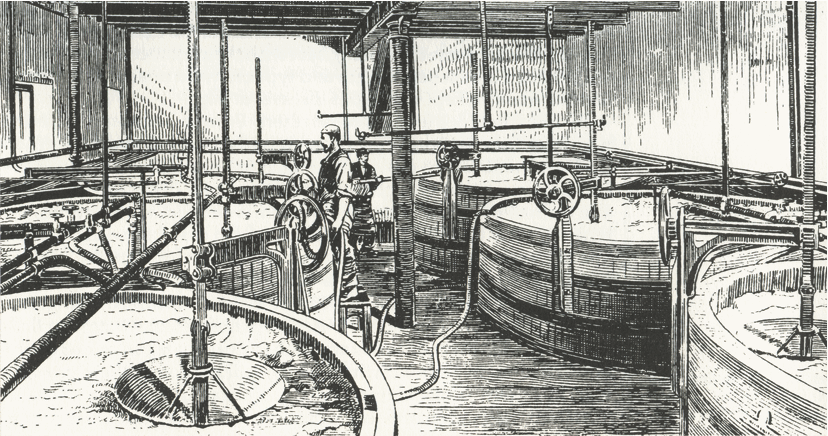If yeast didn’t exist, Douglas Adams would have had to invent it.
Little wonder that the foamy evidence of yeast in action was known to brewers in the Dark Ages as “Godisgood.”
Among a host of imaginary species, the author of The Hitchhiker’s Guide to the Galaxy created the babelfish, a creature that feeds on the soundwaves of one language and excretes the soundwaves of a different language. The interplanetary traveler slips a tiny babelfish into his ear—Adams wrote science fiction, after all—and can instantly understand any spoken language in the universe. The babelfish is “so mindbogglingly useful” that it triggers an intergalactic theological debate.

Almost as useful—and as unbelievable—as yeast. Like the fantastical babelfish, yeast goes about its biological business, which is making more yeast, and just happens to produce a byproduct that transforms human perception. Yeasts ingest sugars and excrete a substance that is literally mindboggling—alcohol.
The effect of alcohol on the human mind is profound enough that every ancient society that stumbled on alcohol associated it with the divine. Little wonder that the foamy evidence of yeast in action was known to brewers in the Dark Ages as “Godisgood.” They couldn’t see where it came from, they couldn’t explain it, but they knew it turned mundane ingredients into something inspirational.
Trial and Error
In its beginnings, brewing had to have been a pretty haphazard process. All fermentation would have been of the sort we now call “spontaneous fermentation,” carried out by so-called “wild yeast”—modern terms to distinguish it from the highly controlled fermentation practiced today with known yeast sources.
And yet, brewers in antiquity clearly learned by trial and error how to make conditions most hospitable for the magic of fermentation to occur. Some physical locations must have been better sites for brewing than others, in part because the ambient yeast populations vary from one micro-environment to another. And brewers would have learned the best phase in the brewing process during which to expose their beer to the elements, much the way that modern lambic brewers in Belgium still throw open the brewhouse windows to let in the local wild yeast.
Brewers also learned to save some of one brew to inoculate the next. Brewers’ yeast is unique among yeast species in its tendency to clump together, or flocculate, at the end of fermentation. This quality allowed brewers to collect yeast from the top or the bottom of the fermentation vessel to start the next batch.
In Norse brewing tradition, a family kept a brewing stick that was used to stir the wort (the sweet liquid that will ferment into beer) at a critical stage. The family knew the sticks were valuable enough to pass from one generation to the next, even if they didn’t necessarily know that they were maintaining a colony of yeast on the stick.
By replicating the methods that produced good beer and rejecting the ones that didn’t, by skimming yeast that floated to the surface of the fermentation vessel or collecting what settled to the bottom, brewers inadvertently favored yeast with certain characteristics over others. With careful selection of yeast, brewers could increasingly replicate beer qualities over and over.
And brewers weren’t just looking for the efficient creation of alcohol. Whether the brewers knew it or not, the different types of yeast that thrived in their beer left their mark on the flavor and aroma, as surely as the type of hops, the roasting of the barley, the nature of the water, or the idiosyncratic techniques of the brewer.
Legislation and Science
Of the four ingredients of beer, yeast was the last to be identified. The original Reinheitsgebot, the Bavarian Purity Law of 1516, specified barley, hops and water as the only legal ingredients of beer. Yeast, the agent that turned the other three ingredients into beer, was not mentioned.
In the next century, Dutch amateur naturalist Anton van Leeuwenhoek found life everywhere he turned his microscope—tiny “animalcules,” including yeast cells, which he described for the first time in 1680. Nearly two hundred year later, in 1866, Louis Pasteur confirmed the role of yeast in the fermentation of beer.
These men observed living organisms whose life cycle made scientific sense of the brewing process. The infant science of microbiology joined the centuries-old skills of brewers.
Yeast is a single-celled organism: specifically, a type of fungi. Yeasts are found everywhere, on surfaces and floating in the air. They thrive and multiply quickly on sources of sugar—which describes beer wort perfectly—and release equal parts of alcohol and carbon dioxide, which gives beer its fizz.
In a third scientific breakthrough, in 1883, Emil Hansen at the Carlsberg Laboratories in Copenhagen isolated a pure yeast type with individual characteristics—which we know now as a distinct yeast strain. His techniques allowed the identification of different strains that operated best at different temperatures, utilized raw material at different rates, and produced different mixes of byproducts. With access to pure strains, brewers had much greater control over the beer they brewed.









